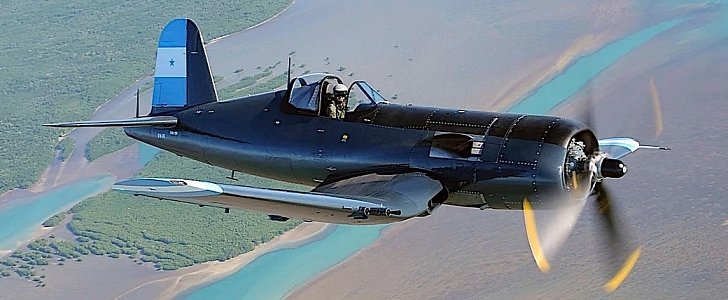The airplanes of the Second World War have been incredible machines. Designed and built on fast-forward to meet the ever-changing requirements of combat situations, they all, almost without exception, succeeded in their tasks no matter who built them.
As did most other nations involved in the conflict, America had its fair share of killer fliers. Among them was the Vought F4U Corsair, one of the most common fighters in the skies over the Pacific during the war years, and later above Korea.
Having entered service in 1940 as a mostly carrier-based aircraft, it quickly rose to the star-of-the-battlefield status, with a recorded kill ratio of 11 to 1. Its victims were of course Japanese pilots, who quickly came to recognize and fear the sight of the Corsair. Americans, on the other hand, knew it as the Angel of Okinawa.
Over 12,000 of these airplanes were made, in close to 20 different variants, and after the war some of them were employed by other nations. One of the biggest Corsair fan-state was Honduras (other South American nations got it too, and so did New Zealand) which kept using it until 1979, more than 20 years after the airplane exited its role as U.S. Navy machine.
The Corsair we have in the gallery above, built in 1951, may not have been part of the war, but the hero genes are still there. It is of the F4U-5N variety, specifically designed to handle night missions. Shortly after it was made it got sold, and It served in the Honduras Air Force for a number of years before being purchased by a movie prop company based in the U.S.
Now the airplane sits in Australia somewhere, where it arrived in 1996, and is waiting for a new owner. It’s no longer weaponized, of course, but it has been restored over the course of 17 years, down to the Glossy Sea Blue paint and the Fuerza Aerea Hondurena insignia from back in its glory days.
The first post-restoration flight dates to 2014, and it has been flown for a little over 47 hours.
Having entered service in 1940 as a mostly carrier-based aircraft, it quickly rose to the star-of-the-battlefield status, with a recorded kill ratio of 11 to 1. Its victims were of course Japanese pilots, who quickly came to recognize and fear the sight of the Corsair. Americans, on the other hand, knew it as the Angel of Okinawa.
Over 12,000 of these airplanes were made, in close to 20 different variants, and after the war some of them were employed by other nations. One of the biggest Corsair fan-state was Honduras (other South American nations got it too, and so did New Zealand) which kept using it until 1979, more than 20 years after the airplane exited its role as U.S. Navy machine.
The Corsair we have in the gallery above, built in 1951, may not have been part of the war, but the hero genes are still there. It is of the F4U-5N variety, specifically designed to handle night missions. Shortly after it was made it got sold, and It served in the Honduras Air Force for a number of years before being purchased by a movie prop company based in the U.S.
Now the airplane sits in Australia somewhere, where it arrived in 1996, and is waiting for a new owner. It’s no longer weaponized, of course, but it has been restored over the course of 17 years, down to the Glossy Sea Blue paint and the Fuerza Aerea Hondurena insignia from back in its glory days.
The first post-restoration flight dates to 2014, and it has been flown for a little over 47 hours.







